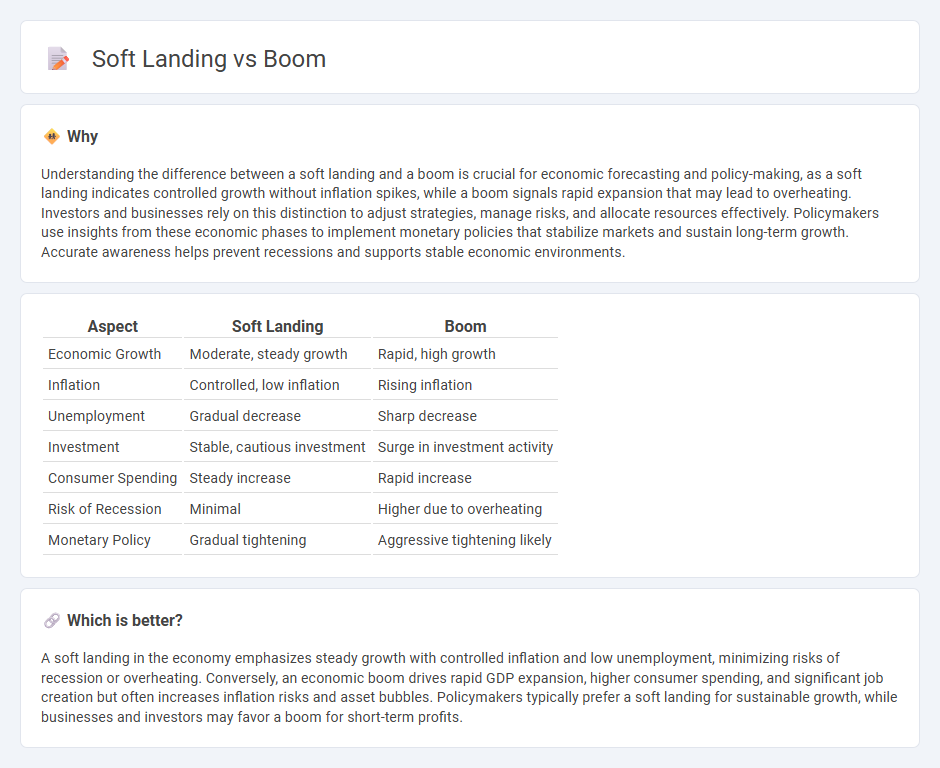
A soft landing in the economy refers to a gradual slowdown in growth that avoids recession, maintaining stable employment and inflation levels. In contrast, an economic boom is characterized by rapid expansion, increased consumer spending, and rising asset prices, often accompanied by higher inflation risks. Explore the key differences between these economic scenarios to understand market trends and investment strategies.
Why it is important
Understanding the difference between a soft landing and a boom is crucial for economic forecasting and policy-making, as a soft landing indicates controlled growth without inflation spikes, while a boom signals rapid expansion that may lead to overheating. Investors and businesses rely on this distinction to adjust strategies, manage risks, and allocate resources effectively. Policymakers use insights from these economic phases to implement monetary policies that stabilize markets and sustain long-term growth. Accurate awareness helps prevent recessions and supports stable economic environments.
Comparison Table
| Aspect | Soft Landing | Boom |
|---|---|---|
| Economic Growth | Moderate, steady growth | Rapid, high growth |
| Inflation | Controlled, low inflation | Rising inflation |
| Unemployment | Gradual decrease | Sharp decrease |
| Investment | Stable, cautious investment | Surge in investment activity |
| Consumer Spending | Steady increase | Rapid increase |
| Risk of Recession | Minimal | Higher due to overheating |
| Monetary Policy | Gradual tightening | Aggressive tightening likely |
Which is better?
A soft landing in the economy emphasizes steady growth with controlled inflation and low unemployment, minimizing risks of recession or overheating. Conversely, an economic boom drives rapid GDP expansion, higher consumer spending, and significant job creation but often increases inflation risks and asset bubbles. Policymakers typically prefer a soft landing for sustainable growth, while businesses and investors may favor a boom for short-term profits.
Connection
A soft landing occurs when an economy slows down just enough to prevent inflation without triggering a recession, allowing sustained growth. This controlled deceleration often sets the stage for a boom by maintaining consumer confidence and investment momentum. Effective monetary policies and stable labor markets play crucial roles in achieving a soft landing that leads to an economic boom.
Key Terms
GDP Growth
A boom in GDP growth is characterized by rapid economic expansion typically exceeding 4% annually, driven by strong consumer spending, investment, and industrial output. In contrast, a soft landing involves a gradual slowdown of GDP growth to a sustainable rate, often around 2%, avoiding recession while taming inflation and overheating risks. Explore more to understand how policymakers navigate these economic phases to stabilize growth.
Inflation Rate
A boom typically leads to soaring inflation rates as demand outpaces supply, causing prices to rise rapidly. In contrast, a soft landing aims to moderate inflation by cooling economic growth without triggering a recession, stabilizing prices around central bank targets. Explore detailed analysis to understand how inflation trends differ between boom and soft landing scenarios.
Monetary Policy
Monetary policy plays a crucial role in shaping the outcomes of economic cycles, with a boom often characterized by aggressive interest rate hikes to cool overheating markets, while a soft landing is achieved through gradual adjustments to prevent abrupt economic slowdowns. Central banks use tools like policy rate changes, quantitative easing, and forward guidance to balance inflation control and growth sustainability. Explore how strategic monetary policy decisions influence the delicate path between booming growth and a smooth economic transition.
Source and External Links
BOOM | definition in the Cambridge English Dictionary - "Boom" primarily refers to a period of sudden economic growth and can also mean a loud, deep sound such as a bang or thump, highlighting its multiple meanings including economic and acoustic contexts.
Boom - Supersonic Passenger Airplanes - Boom is an aerospace company building commercial supersonic aircraft, including the XB-1 demonstrator and the Overture airliner designed to fly at twice the speed of conventional jets.
Boom Cards by Boom Learning - Interactive Lessons by Educators - Boom Learning provides an educational platform with personalized, interactive digital lessons called Boom Cards, designed to support diverse learning styles and improve student engagement and outcomes.
 dowidth.com
dowidth.com